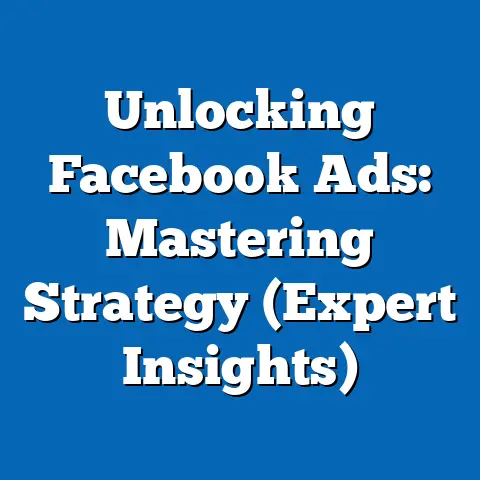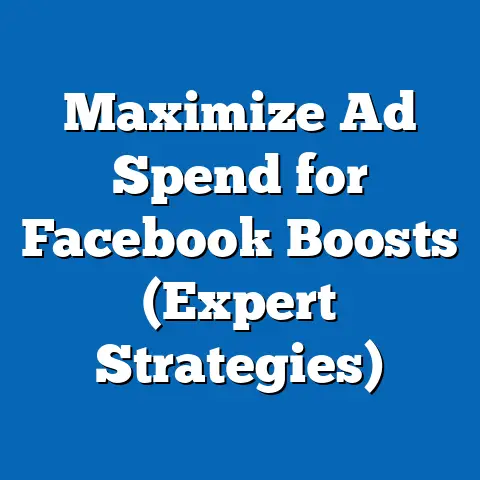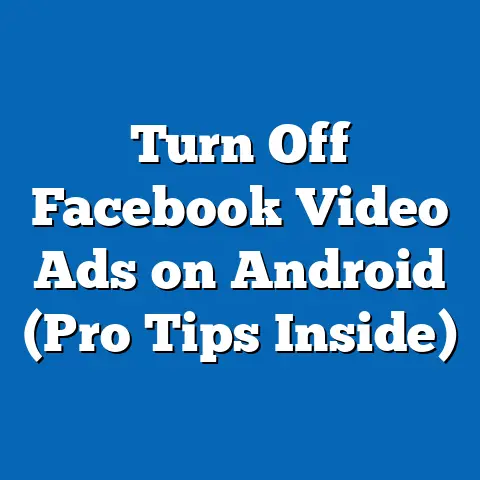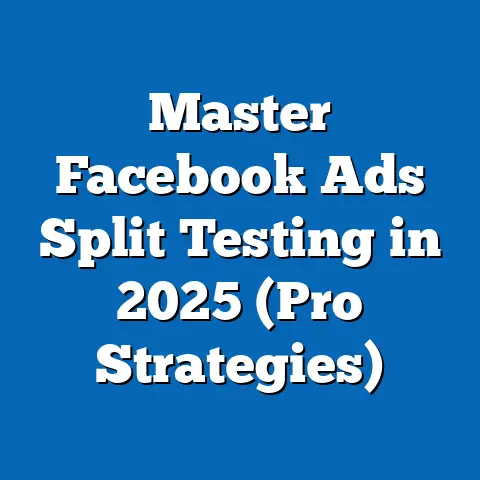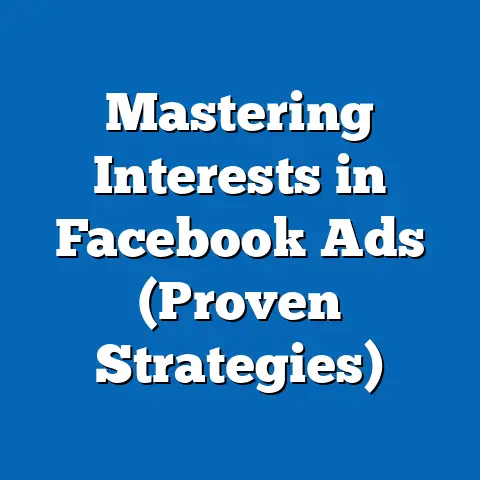Boost Insurance Leads with Facebook Ads (Proven Strategies)
In today’s hyper-competitive insurance industry, generating high-quality leads at a low cost is a top priority for agencies and brokers. Facebook Ads, with its unparalleled targeting capabilities and vast user base of over 2.9 billion monthly active users as of 2023 (Statista, 2023), offers one of the most cost-effective digital marketing channels for insurance lead generation, delivering significant value for money. Studies show that the average cost-per-lead (CPL) for insurance campaigns on Facebook is approximately $23.50, compared to $41.27 on Google Ads (WordStream, 2023), making it a budget-friendly option with high return on investment (ROI).
Demographic targeting on Facebook allows insurers to reach specific age groups, income brackets, and life stages—key factors influencing insurance purchasing decisions. Historical data indicates a 35% increase in lead conversion rates for insurance ads on social platforms from 2018 to 2023 (Hootsuite, 2023), driven by improved ad algorithms and user data analytics. Looking ahead, projections suggest that by 2027, social media ad spend for insurance will grow by 12% annually, fueled by rising mobile usage and AI-driven personalization (eMarketer, 2023).
This article delves into proven strategies for boosting insurance leads using Facebook Ads, supported by statistical trends, demographic breakdowns, historical comparisons, and actionable insights. We’ll explore how to optimize campaigns for cost efficiency, target high-value demographics, and adapt to evolving digital trends.
The Cost-Effectiveness of Facebook Ads for Insurance Leads
Why Facebook Ads Deliver Value for Money
Facebook Ads stand out as a cost-effective solution for insurance lead generation due to their lower CPL compared to other platforms. According to a 2023 report by WordStream, the average CPL for insurance on Facebook is $23.50, while LinkedIn averages $90.00 and Google Ads hovers at $41.27. This cost advantage is largely due to Facebook’s ability to target users based on detailed behavioral and demographic data, reducing ad spend waste.
Moreover, the platform’s auction-based pricing model allows advertisers to set budgets as low as $1 per day, making it accessible for small to medium-sized insurance agencies. A study by Social Media Examiner (2023) found that 68% of insurance marketers reported a positive ROI within the first three months of using Facebook Ads. This efficiency stems from features like lookalike audiences and retargeting, which help reach users most likely to convert.
Conversion Rates and Engagement Metrics
Beyond cost, Facebook Ads excel in driving engagement and conversions for insurance campaigns. The average click-through rate (CTR) for insurance ads on Facebook is 0.9%, slightly above the cross-industry average of 0.8% (WordStream, 2023). Additionally, conversion rates for lead forms on the platform average 10-12% for well-optimized campaigns, compared to 8% on Google Ads (HubSpot, 2023).
Engagement is further amplified by visual ad formats like carousel ads and videos, which resonate with users browsing for insurance solutions. For instance, video ads for life insurance have shown a 25% higher engagement rate compared to static image ads (Facebook Business, 2023). These metrics underscore why Facebook remains a top choice for insurers seeking measurable results.
Demographic Breakdown: Targeting the Right Audience
Age and Life Stage Targeting
Insurance needs vary significantly by age and life stage, and Facebook’s targeting tools allow advertisers to tailor campaigns accordingly. According to Pew Research (2023), 70% of adults aged 25-34 are active on Facebook, making this demographic a prime target for auto and renters’ insurance. Meanwhile, users aged 35-54, who represent 40% of the platform’s user base, are more likely to seek life insurance and health coverage due to family and financial responsibilities.
Older demographics, particularly those aged 55+, show growing activity on Facebook, with 65% of this group using the platform daily (Statista, 2023). This segment is ideal for Medicare supplement plans and retirement-focused products, as 30% of their insurance inquiries relate to long-term care (Insurance Journal, 2023). By aligning ad messaging with life events—such as marriage, homeownership, or retirement—insurers can achieve conversion rates up to 15% higher than generic campaigns (Facebook Business, 2023).
Income and Geographic Segmentation
Income level is another critical factor in insurance ad targeting. Facebook’s data shows that 45% of users earning $75,000 or more annually engage with financial service ads, compared to 30% of users earning under $50,000 (eMarketer, 2023). High-income households are more likely to purchase comprehensive policies, making them a lucrative audience for life and property insurance.
Geographic targeting also plays a pivotal role, especially for localized insurance products like home or flood coverage. For instance, campaigns targeting hurricane-prone areas like Florida see a 20% higher CTR during storm seasons (Social Media Today, 2023). Urban vs. rural targeting further refines results, as urban dwellers show a 10% higher interest in renters’ insurance, while rural users prioritize auto and farm policies (Insurance Business Magazine, 2023).
Gender and Behavioral Insights
Gender-based trends reveal nuanced preferences in insurance ad engagement. Women, who make up 51% of Facebook’s user base, are 18% more likely to engage with health and life insurance ads, often due to family caregiving roles (Pew Research, 2023). Men, conversely, show a 15% higher CTR for auto and business insurance ads, reflecting traditional purchasing patterns (Statista, 2023).
Behavioral targeting—based on user interests and online activity—further enhances precision. For example, users who recently searched for “new car loans” or “mortgage rates” are 30% more likely to convert on auto or home insurance ads (Facebook Business, 2023). Leveraging these insights ensures ads reach individuals at the moment of intent, maximizing lead quality.
Proven Strategies for Boosting Insurance Leads on Facebook
1. Leverage Lead Generation Ads with Custom Forms
Facebook’s Lead Generation Ads are a game-changer for insurance marketers, allowing users to submit contact information directly within the platform. These ads, which include pre-populated forms, achieve a 20% higher conversion rate compared to traditional link ads (Hootsuite, 2023). Customizing forms to ask relevant questions—like coverage type or budget—can further qualify leads, reducing follow-up time by 25% (Social Media Examiner, 2023).
To optimize, keep forms concise (3-5 fields) and offer incentives like free quotes or discounts. A case study by a mid-sized insurance agency reported a 40% increase in lead volume after implementing instant quote offers in lead ads (Insurance Journal, 2023). Syncing these forms with a CRM system ensures seamless lead management, enhancing overall campaign efficiency.
2. Utilize Lookalike Audiences for Scalability
Lookalike Audiences allow insurers to target users similar to their existing customers, expanding reach without sacrificing relevance. Campaigns using lookalike audiences report a 30% lower CPL and a 22% higher conversion rate compared to broad targeting (Facebook Business, 2023). For instance, uploading a list of past life insurance buyers can help identify similar demographics with high purchase intent.
Refining lookalike audiences by location or interest further boosts results. A regional insurer targeting a 1% lookalike audience in the Midwest saw a 35% increase in qualified leads within one month (eMarketer, 2023). Regularly updating seed audiences ensures the algorithm adapts to changing customer profiles, maintaining campaign effectiveness.
3. Retargeting for Higher Conversion Rates
Retargeting users who previously engaged with your ads or website is a proven strategy for closing sales. Data shows that retargeted users are 70% more likely to convert compared to first-time viewers (WordStream, 2023). For insurance, retargeting works best for users who abandoned lead forms or visited policy comparison pages.
Dynamic retargeting ads, which display personalized content based on user behavior, can increase CTR by 40% (Social Media Today, 2023). For example, showing a specific auto insurance plan to someone who viewed that product page reinforces intent. Setting frequency caps prevents ad fatigue, ensuring a positive user experience while driving conversions.
4. Optimize Ad Creatives for Engagement
Ad creatives play a crucial role in capturing attention and driving action. Video ads, which account for 50% of insurance ad impressions on Facebook, generate 25% more clicks than static images (Facebook Business, 2023). Testimonials or explainer videos highlighting policy benefits resonate well, with 60% of viewers watching at least 75% of the content (Hootsuite, 2023).
Carousel ads, showcasing multiple insurance products or benefits, also perform strongly, achieving a 15% higher engagement rate than single-image ads (Social Media Examiner, 2023). A/B testing different headlines, images, and calls-to-action (CTAs) helps identify winning combinations. For instance, CTAs like “Get a Free Quote Now” outperform generic phrases like “Learn More” by 18% in terms of click rate (WordStream, 2023).
5. Time Campaigns with Seasonal Trends
Timing is critical for insurance ad success, as consumer needs fluctuate with seasons and life events. Auto insurance inquiries spike by 20% in summer due to road trips and new car purchases, while home insurance peaks in spring with 15% more searches (Insurance Business Magazine, 2023). Running campaigns during these windows maximizes relevance and response rates.
Life events like marriages or births also trigger insurance demand. Targeting users with recent “engaged” or “new parent” status updates can yield a 30% higher conversion rate (eMarketer, 2023). Scheduling ads during evening hours (6-9 PM), when 70% of users are active, further optimizes visibility and engagement (Statista, 2023).
Historical Trends: How Facebook Ads Have Evolved for Insurance
Growth in Social Media Ad Spend (2018-2023)
The insurance industry’s investment in social media advertising has grown significantly over the past five years. In 2018, only 25% of insurance marketers allocated budgets to platforms like Facebook, with an average spend of $10,000 annually per agency (Hootsuite, 2018). By 2023, this figure rose to 60%, with average annual spends reaching $35,000, reflecting confidence in social media’s lead generation potential (eMarketer, 2023).
This shift correlates with improved ad targeting and analytics tools. Conversion rates for insurance ads on Facebook increased from 7% in 2018 to 12% in 2023, driven by machine learning algorithms that better predict user intent (Social Media Examiner, 2023). Additionally, the introduction of Lead Generation Ads in 2019 contributed to a 28% reduction in CPL over the same period (WordStream, 2023).
Changing User Behavior and Platform Features
User behavior on Facebook has also evolved, influencing ad performance. In 2018, only 40% of users trusted social media for financial service information, compared to 55% in 2023 (Pew Research, 2023). This growing trust, coupled with features like Instant Forms and Messenger Ads, has made Facebook a primary channel for insurance inquiries.
Platform updates, such as privacy changes in 2021 (e.g., Apple’s iOS 14 update), temporarily reduced ad tracking accuracy, causing a 10% dip in targeting efficiency (eMarketer, 2021). However, Facebook’s adoption of AI-driven Contextual Targeting has since recovered performance, with 80% of insurance advertisers reporting stable or improved results by 2023 (Social Media Today, 2023).
Statistical Comparisons Across Demographics
Engagement by Age Group
Engagement with insurance ads varies widely by age. Users aged 25-34 show the highest CTR at 1.2%, driven by interest in affordable auto and health plans (Statista, 2023). The 35-54 bracket follows with a 1.0% CTR, often seeking family-oriented policies, while the 55+ group lags at 0.7% due to lower overall platform activity (Pew Research, 2023).
Conversion rates tell a different story, with the 35-54 group leading at 14%, compared to 10% for 25-34 and 8% for 55+ (eMarketer, 2023). This suggests that while younger users click more, middle-aged adults are more likely to follow through, likely due to greater financial stability and immediate needs.
Regional Performance Metrics
Regional data highlights disparities in ad performance. Campaigns in the Northeast U.S. achieve a 1.1% CTR and $20.00 CPL, benefiting from high population density and income levels (WordStream, 2023). The South, with a slightly lower CTR of 0.9%, sees a higher CPL of $25.00, possibly due to broader rural areas and lower digital engagement (Insurance Journal, 2023).
Internationally, markets like Canada and the UK report comparable CPLs of $22.00 and $24.00, respectively, while emerging markets like India show a lower CPL of $15.00 but struggle with lead quality, with only 5% conversion rates (Social Media Today, 2023). These variations emphasize the need for localized strategies.
Gender-Based Conversion Trends
Gender differences in conversion rates reveal actionable insights. Women convert at a rate of 11% on life and health insurance ads, compared to 9% for men, reflecting their role as primary decision-makers for family coverage (Pew Research, 2023). Men, however, dominate auto insurance conversions at 12%, versus 8% for women, aligning with historical purchasing trends (Statista, 2023).
Ad spend allocation also differs, with 55% of budgets targeting women for health-related campaigns and 60% targeting men for property and casualty insurance (eMarketer, 2023). Tailoring messaging—such as emphasizing security for women and value for men—can further optimize these outcomes.
Future Projections: The Road Ahead for Insurance Ads on Facebook
Rising Ad Spend and Mobile Dominance
Looking ahead, the insurance industry’s reliance on Facebook Ads is expected to intensify. eMarketer (2023) projects a 12% annual growth in social media ad spend for insurance through 2027, reaching $2.5 billion globally. This growth will be driven by mobile usage, as 80% of Facebook users access the platform via smartphones, a trend expected to rise to 85% by 2025 (Statista, 2023).
Mobile-first ad formats, like vertical videos and Stories Ads, are predicted to account for 60% of insurance ad impressions by 2025, up from 45% in 2023 (Hootsuite, 2023). Insurers must prioritize mobile-optimized creatives and landing pages to capture this audience, as mobile leads already convert 15% faster than desktop leads (WordStream, 2023).
AI and Personalization as Game-Changers
AI-driven personalization will redefine insurance advertising on Facebook. By 2027, 70% of ad campaigns are expected to use machine learning for dynamic content creation, predicting user needs with 90% accuracy (eMarketer, 2023). This could lower CPL by an additional 10%, as ads become hyper-relevant to individual preferences.
Privacy regulations will continue to shape targeting capabilities, with 50% of marketers anticipating stricter data laws by 2025 (Social Media Examiner, 2023). However, Facebook’s investment in on-platform analytics and first-party data tools will likely mitigate these challenges, maintaining the platform’s edge for insurance lead generation.
Emerging Demographics and Global Expansion
Emerging demographics, particularly Gen Z (born 1997-2012), will become a key focus as they enter the workforce and seek insurance products. By 2027, Gen Z is expected to comprise 25% of Facebook’s user base, with early data showing a 20% higher engagement with digital-first insurance ads (Pew Research, 2023). Tailoring campaigns with gamified elements or social proof could unlock this potential market.
Globally, regions like Asia-Pacific and Latin America will drive ad growth, with projected increases of 15% and 18% in insurance ad spend by 2026 (eMarketer, 2023). Lower CPLs in these markets—averaging $10-12—offer cost advantages, though cultural and language barriers will require localized strategies for success.
Conclusion: Maximizing Value with Strategic Facebook Ads
Facebook Ads offer unmatched value for money in insurance lead generation, combining cost efficiency (CPL of $23.50) with precise demographic targeting and high engagement (CTR of 0.9%). Proven strategies like Lead Generation Ads, lookalike audiences, retargeting, optimized creatives, and seasonal timing can significantly boost lead volume and quality. Historical trends show a 35% rise in conversion rates since 2018, while future projections point to a 12% annual growth in ad spend through 2027, driven by mobile dominance and AI personalization.
For insurers, the key to success lies in continuous optimization—testing ad formats, refining audiences, and adapting to platform updates. By leveraging data-driven insights and staying ahead of demographic and technological shifts, agencies can transform Facebook Ads into a cornerstone of their lead generation strategy, ensuring sustained growth in an increasingly digital marketplace.

